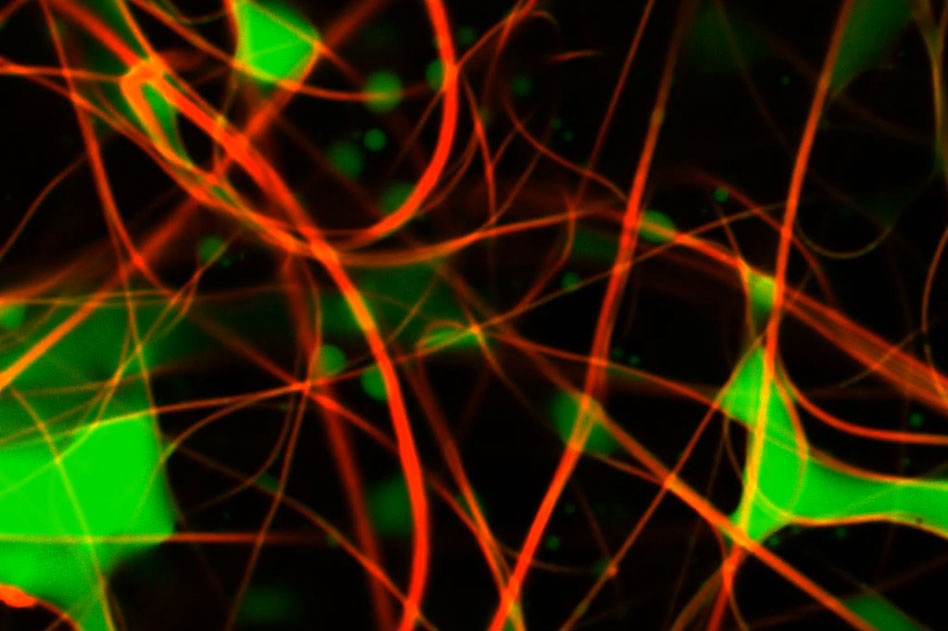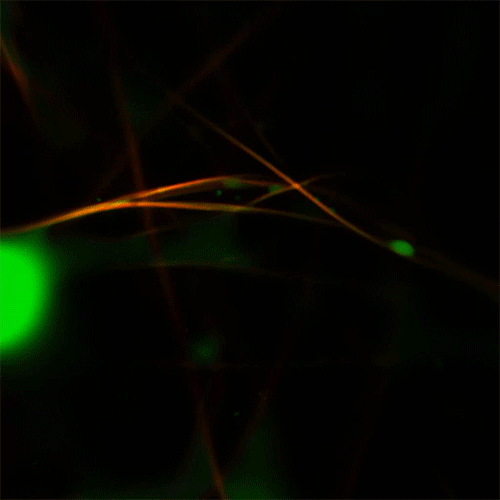Jun 11 2019
It is a well-known fact that oil and water never mix completely together. However, isolating them fully—for instance, when purifying water contaminated through fracking or cleaning up an oil spill—is an extremely inefficient and difficult process that often depends on membranes that are likely to get “fouled” or clogged up.
 Image taken using the MIT researchers’ system shows the fibers of the filter membrane in red, and the oily droplets accumulating on it in green. The colors results from fluorescent dyes added to the materials. (Image credit: MIT)
Image taken using the MIT researchers’ system shows the fibers of the filter membrane in red, and the oily droplets accumulating on it in green. The colors results from fluorescent dyes added to the materials. (Image credit: MIT)
Now, MIT has developed a novel technique that offers a tool for creating more improved membrane materials that are capable of preventing or resisting fouling. The latest work has been detailed in the journal, Applied Materials and Interfaces, in a paper written by Chen Song and Yi-Min Lin, who are MIT graduate students, and by Gregory Rutledge, a professor of chemical engineering.
In several industries, including metal finishing, food processing, and petroleum refining, it is important to clean up oily wastewater but this untreated waste can damage aquatic ecosystems. Strategic approaches to eliminating oily contaminants can differ, based on the sizes of the oil droplets and the relative amounts of water and oil. During oil emulsification, membranes provide the most efficient cleanup technique. These membranes are used to filter out the small oil droplets, but they can rapidly get fouled by the oil droplets and need time-intensive cleaning procedures.
However, it is very difficult to observe this fouling process which makes it rather hard to evaluate the relative benefits of various architectures and materials for the membranes themselves. Now, with the latest method developed by the MIT researchers, such assessments could be carried out more easily, stated the researchers.
Such filtration membranes “tend to be very hard to look inside of,” Rutledge stated. “There’s a lot of effort to develop new types of membranes, but when they get put in service, you want to see how they interact with the contaminated water, and they don’t lend themselves to easy examination. They are usually designed to pack in as much membrane area as possible, and being able to look inside is very hard.”
The solution developed by the MIT team utilizes confocal laser scanning microscopy—a method in which a pair of lasers is scanned across the material—and a material labeled with a fluorescent dye glows at the point where both the beams cross. In their latest technique, the researchers introduced a couple of fluorescent dyes—one to label the fibers in the filtration membrane, and the other to label the oily material in the fluid.
The method enables the material to be scanned across the membrane area and also into the depth of the material, in a layer by layer fashion, to construct a complete 3D image of the way the oil droplets are distributed in the membrane, which, in this example, contains a wide range of tiny fibers.

Rutledge explained that the rudimentary technique has been applied in biological research, to view proteins and cells inside a sample; however, it has not been used much for analyzing membrane materials, and never with both the fibers and the oil labeled. In this example, the team is viewing droplets that differ in size from around 10 to 20 µm (millionths of a meter) to as small as a few hundred nanometers (billionths of a meter).
Until now, “methods for imaging pore spaces in membranes were pretty crude.” Rutledge said. In most cases, the pore properties were deduced by determining the flow rates and the changes in pressure via the material, providing no direct data about how the oily material essentially accumulates in the pores. With the latest process in place, Rutledge stated that “now you can actually measure the geometry, and build a three-dimensional model and characterize the material in some detail. So what’s new now is that we can really look at how separation takes place in these membranes.”
When this is done and the impacts are tested using different arrangements of the fibers and different materials, “this should give us a better understanding of what fouling really is,” he added.
The researchers have already shown that the interaction that occurs between the membrane and the oil can be extremely different based on the type of material utilized. In certain cases, the oil creates small droplets that slowly coalesce to create larger ones, whereas, in other instances, the oil spreads out in a layer along the fibers—a process referred to as wetting.
“The hope is that with a better understanding of the mechanism of fouling, people will be able to spend more time on the techniques that are more likely to succeed” in reducing that fouling, Rutledge stated.
According to Rutledge, the novel observational technique has evident applications for engineers who are attempting to come up with more improved filtration systems, but it can also be utilized for research on the fundamental science of how different fluids interact.
Now we can begin to think about some fundamental science on the interaction between two-phase liquid flows and porous media. Now, you can develop some detailed models of the process.
Gregory Rutledge, Professor, Department of Chemical Engineering, MIT
And the comprehensive data about how varied chemistries or structures perform could render it easier to design particular kinds of membranes for a wide range of applications, based on the types of contaminants to be eliminated, the standard sizes of the droplets in these contaminants, etc.
In designing membranes, it’s not a one-size-fits-all. Potentially you can have different types of membranes for different effluents.
Gregory Rutledge, Professor, Department of Chemical Engineering, MIT
In addition, the technique could be used for observing the separation of varied kinds of mixtures, like the presence of solid particles in a liquid, or a reverse situation in which the oil is dominant and water droplets are filtered out using the membrane, for example, in a fuel filtration system, stated Rutledge.
When I read his paper in depth, I was impressed by Greg’s way of using 3D imaging to understand the complex fouling process in membranes used for oil-water emulsions.
William J. Koros, the Roberto C. Goizueta Chair for Excellence in Chemical Engineering and GRA Eminent Scholar in Membranes, Georgia Institute of Technology
Koros was not involved in the study.
The study was partly supported by the cooperative agreement between MIT and the Masdar Institute of Science and Technology in Abu Dhabi.